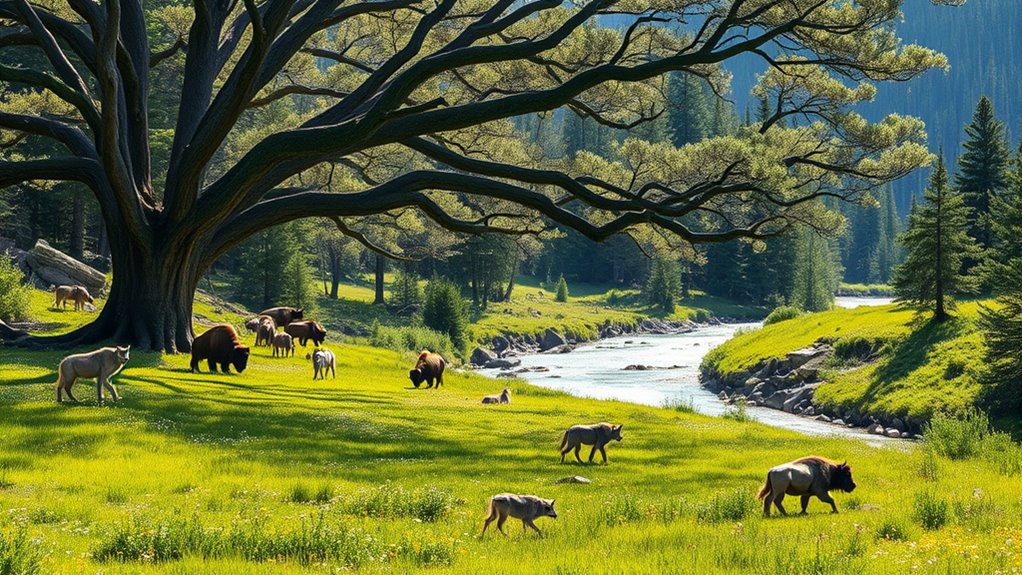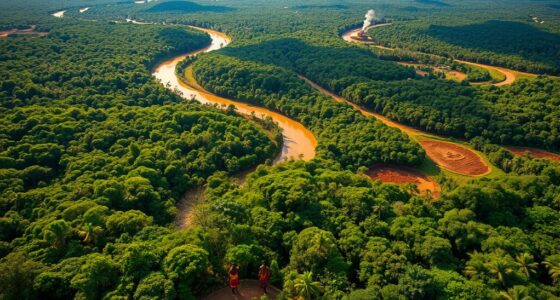The rewilding movement focuses on restoring lost species and habitats to rebuild healthy, resilient ecosystems. By reconnecting fragmented landscapes, it helps wildlife migrate and thrive, even amid urban growth. Managing invasive species and involving communities through education are key to success. This movement aims to create sustainable environments that support biodiversity and natural beauty for future generations. To discover how these efforts are transforming landscapes, keep exploring the positive impacts rewilding can have on our world.
Key Takeaways
- Rewilding aims to restore lost habitats and reintroduce native species to revive ecological balance.
- It involves connecting fragmented ecosystems through corridors to support wildlife migration.
- Managing invasive species is essential to enable native species to recover and thrive.
- Community involvement and education are vital for successful rewilding initiatives.
- Rewilding enhances biodiversity, climate resilience, and environmental health for future sustainability.

Have you ever wondered how restoring natural ecosystems can benefit both the environment and future generations? As urban expansion continues to swallow up green spaces, it becomes essential to find ways to counteract the damage caused by sprawling cities. Rewilding offers a compelling solution, focusing on returning land to its natural state and reestablishing native species and habitats. When cities grow, they often fragment ecosystems, making it harder for wildlife to thrive. By actively restoring these areas, you help create corridors that connect fragmented habitats, allowing animals to migrate, find food, and reproduce more effectively. This process not only supports biodiversity but also enhances resilience against environmental threats like climate change.
Restoring ecosystems connects fragmented habitats, supporting wildlife migration, biodiversity, and resilience against climate change.
However, urban expansion also invites the challenge of invasive species, which often capitalize on disturbed environments. These non-native plants and animals outcompete indigenous species, disrupting the delicate balance of local ecosystems. As part of the rewilding movement, you play a key role in managing these invasives. Removing or controlling invasive species helps native plants and animals regain their footing, restoring the natural harmony that has been lost. This effort requires careful planning and ongoing maintenance, but it pays off by allowing native ecosystems to recover and flourish. Rewilding isn’t just about planting trees; it involves a strategic approach to reversing the damages caused by human activity, including the unchecked spread of invasive species that threaten biodiversity. Incorporating native species restoration strategies is vital for successful ecological recovery. Additionally, utilizing scientific monitoring techniques can optimize rewilding efforts by tracking ecological changes and invasive species spread. Supporting adaptive management approaches ensures that restoration remains effective over time by responding to new challenges and data. Developing restoration guidelines based on scientific research can further improve the effectiveness of these projects.
Involving local communities in rewilding projects can make a significant difference. When people understand the importance of native species and habitats, they’re more likely to support efforts to combat invasive species and restore ecosystems. This can include planting native plants, removing invasives, and creating protected areas. Educational programs and citizen science initiatives empower you to become active participants in rewilding, turning passive conservation into a collective effort. Engaging community involvement in these initiatives can significantly improve the success rates of ecological restoration projects. The benefits extend beyond ecological health; rewilding can improve air and water quality, reduce urban heat, and even enhance mental well-being by reconnecting people with nature.
Ultimately, rewilding is about more than just undoing damage; it’s about creating a sustainable future. Restoring ecosystems allows nature to take its course, fostering a resilient environment capable of withstanding future challenges. By addressing issues like urban expansion and invasive species head-on, you contribute to a movement that not only rebuilds habitats but also restores the natural balance that supports all life on Earth. Your involvement can help guarantee that future generations inherit a planet rich in biodiversity and natural beauty, proving that even in the face of human development, nature can recover and thrive.
Frequently Asked Questions
How Do Rewilding Projects Affect Local Communities Economically?
Rewilding projects can boost your local economy through eco tourism benefits, attracting visitors who want to experience natural habitats and wildlife. These projects often foster community engagement, creating jobs and supporting local businesses. As you get involved, you’ll see how increased tourism can lead to better infrastructure and services, ultimately helping your community thrive economically while preserving the environment. This positive cycle benefits both the land and the people living nearby.
What Are the Biggest Challenges Faced in Reintroducing Extinct Species?
You face significant challenges in reintroducing extinct species. One startling statistic shows over 75% of species are threatened due to habitat fragmentation. You must guarantee sufficient genetic diversity; otherwise, populations risk inbreeding and decline. Habitat fragmentation complicates reestablishment efforts, making it hard for species to survive and thrive. You need careful planning and habitat restoration to overcome these hurdles and give these species a fighting chance at survival.
How Is Rewilding Funded and Sustained Long-Term?
You might wonder how rewilding projects stay funded and sustainable over time. Funding strategies often include government grants, private donations, and partnerships with conservation organizations. To guarantee long-term sustainability, you need ongoing support, community engagement, and adaptive management plans. By diversifying funding sources and demonstrating ecological and social benefits, you can help secure the financial stability needed for rewilding efforts to thrive in the long run.
What Criteria Determine Suitable Habitats for Reintroduction?
You want to know what makes a habitat suitable for reintroduction. Habitat suitability depends on factors like food availability, predator presence, and habitat size. Reintroduction criteria also include the habitat’s ability to support the species long-term and its resilience to human impact. You should assess whether the area can sustain the species’ ecological needs and guarantee a safe, thriving environment before considering reintroduction.
How Does Rewilding Impact Existing Ecosystems and Biodiversity?
You might find that rewilding gently enhances ecosystem balance and enriches species interactions. By reintroducing native species, you support natural processes, fostering resilience and diversity. While there’s a chance it could slightly shift existing dynamics, overall, it encourages a healthier, more vibrant environment. Your efforts help restore harmony among species, ensuring ecosystems thrive and adapt, ultimately benefiting the entire landscape and its inhabitants.
Conclusion
As you embrace rewilding, you become a essential part of nature’s comeback story. Think of it as planting seeds of hope that grow into thriving ecosystems, restoring balance and beauty to our planet. Your actions help bring back lost species and revive habitats, turning the tide against destruction. Together, you hold the power to rewrite nature’s future, transforming our world into a lush, vibrant tapestry where life can flourish once more.








